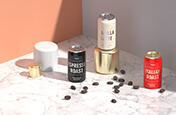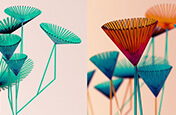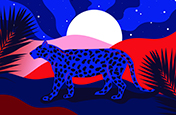Virtual photography: Picture-perfect photos, no studio required.
3D technology is reshaping traditional commercial photoshoot creation with virtual photography. Learn how it can speed up the production of marketing assets, save money, and offer greater flexibility while still delivering the visual impact expected from traditional photography.

Credit: Vladimir Petkovic. Created with Substance by Adobe, Adobe Dimension, and Adobe Stock.
What is virtual photography?
Originating from the world of gaming and visual effects, cutting-edge 3D technology is powering a new frontier of visual asset creation. More and more companies are incorporating 3D-based assets into their marketing and production workflows to save money over expensive studio shoots and produce and distribute assets for the marketplace quicker than ever before.
Brands like IKEA, Coca-Cola, Target, and Amazon are already leveraging 3D technology to benefit from the flexibility offered when iterating design concepts. It can also provide massive improvements in speed and efficiency, and help ensure product and brand consistency across multiple design and marketing initiatives — crucial to any brand, big or small.

Can you tell that this image was created entirely in 3D?
Credit: Daniel Margunato. Created with Substance by Adobe, Autodesk 3ds Max, and Corona Renderer.
At its foundation, virtual photography is imagery that has been crafted to resemble traditional photography and represent images of the real world as shot through a camera lens. But there’s no camera and no lens involved — it’s all crafted on a computer using a combination of 3D models and materials and 2D graphics and images, plus artful lighting to blend everything together. When done right, a virtual photograph can look just like the real thing. Adobe Dimension provides what is essentially a virtual photo studio to stage your scene from scratch, and Substance material authoring lets you take it to the next level and achieve true photorealism. With dedicated practice using these tools, it all results in images that users won’t realize were created in the digital realm.
What are the advantages versus traditional photography?
Utilized properly and with 3D expertise, virtual photography can meet marketing needs quicker than traditional photography, and it allows for more freedom and flexibility along the way. By working solely in the digital realm, you can craft that elusive perfect product shot without needing to build and iterate resource-heavy physical mockups. Apps in the Adobe 3D & AR ecosystem make it easier than ever before to achieve photorealistic scenes that can be viewed and rendered from every angle, providing production-quality assets for all marketing channels. Real-world workflow benchmarks show that using Adobe Dimension for simple images is much faster than traditional methods and can also produce more desirable end results.


Credit: Lifted Kombucha, by John Godfrey. Created with Adobe Dimension and Adobe Illustrator.

Credit: Justin Patton and Vladimir Petkovic. Created with Adobe Dimension.
Virtual photography can help you fulfill all your asset needs by making it easy to alter backgrounds and objects in the shot to create variations big or small. Craft a product shot against a kitchen countertop, then change it out for a coffee table or nightstand so you can cover all types of lifestyle imagery. Or do something as simple as swapping packaging language on product shots to account for every region it’ll be sold in. You can also share templates and scenes among marketing teams across different channels, making it easier than ever to keep things evergreen by allowing designers on any end the flexibility to update photos as needs arise. A new angle, a new crop, a new color, no need to start from scratch — the creative possibilities are infinite.
Showcasing 360-degree views of items on web marketplaces can help customers get a better sense of a product than 2D images can provide. It allows them to view it from multiple angles, rotate and zoom in and out in realtime, as well as change styles, sizes, and colors with just a mouse click. Those same models can be leveraged for interactive AR experiences that allow them to visualize how the product might fit into their own space in the real world. Furniture companies like IKEA offer AR apps that do just that, letting you “place” couches and chairs in your living room via IKEA Place to see if they’re a good fit (in both style and size) before deciding to buy. It’s just one way AR creations can make it easier than ever for companies to showcase their wares — and for customers to decide if they’re right for them.


Both of these images were created with Substance.
Credits: Bedroom: Pasquale Scionti, Chair: Alexander Koval
How to create your own virtual photos from scratch.

Design your 2D elements in Adobe Illustrator or Photoshop.
Use whichever app suits your needs best for creating any 2D components that you might need. Illustrator is great for crafting graphics and logos to place on 3D objects, while Photoshop can be used to create brand images or edit existing photos.

Create new 3D materials using the Substance suite.
Refine the appearance of all the objects in your scene by adding a range of realistic materials. Pull from the robust library offered by Substance Source or, with more 3D practice, personalize your textures using Substance Alchemist.

Build your scene in Dimension.
a) Place 3D models of the objects you need in your scene. Dimension comes with a library of models, materials and lights that you can find in the Starter Assets panel. You can also browse Adobe Stock for even more choices or import models from other sources. Dimension supports OBJ, Autodesk FBX, STL and SketchUp SKP file formats.
b) Place the graphics, logos and other 2D images created in Photoshop or Illustrator on the 3D models, either as decals or fills and then adjust the layer’s material properties to get the look you want.
c) Arrange the objects in the scene where you want them. Experiment with different camera angles, adjust the lighting and materials to find what works best and add a background to your scene. Choose a background image from the Starter Assets panel or Adobe Stock or import your own. Use Match Image to automatically create realistic lighting based on the background image or adjust the Environment Light and Sunlight settings yourself.

Export and share 2D and 3D files from Dimension.
a) Export the images as final files to be used for any type of marketing needs, such as websites, ads, or even virtual product showrooms, and import them into InDesign to lay out for print and digital media.
b) Share and publish traditional 2D images or 3D designs with 360-degree views (with bookmarked camera angles) via web links or embedding on the web. Assets can also be utilized in augmented reality experiences created in Adobe Aero to offer immersive experiences that can showcase products overlaid in the real world. The free Aero app gives viewers an engaging experience that lets them interact with your designs in a whole different way.

Export assets to Photoshop.
By importing the finished image files into Photoshop, you can make minute changes and touch up your images right down to the pixel to further add to the photorealism.
You might also be interested in…
Brand visualisation in 3D & AR: The power of seeing your brand in context.
Discover the tools in the Adobe 3D & AR ecosystem that help visualise any 3D design you can imagine.
Creative Play in 3D & AR: Explore new styles or craft a masterpiece.
The tools in the Adobe 3D & AR ecosystem have everything you need to let your imagination run wild and prepare for the next generation of design.
Environmental design: Showcasing spatial concepts with 3D.
Prototype and visualise spaces such as architectural interiors, signage, floor layouts, retail shop fronts and more.
Learn more about creating art and illustration with this versatile file type.




